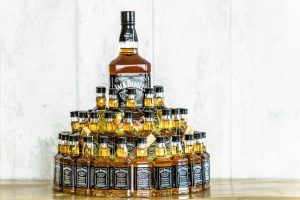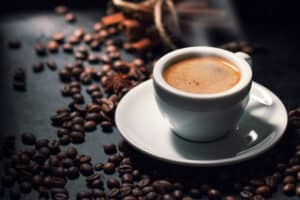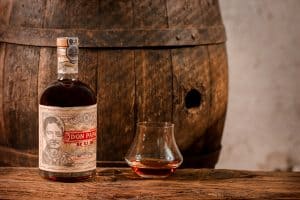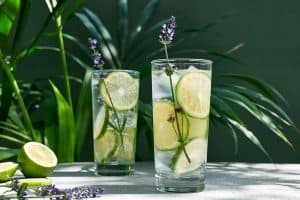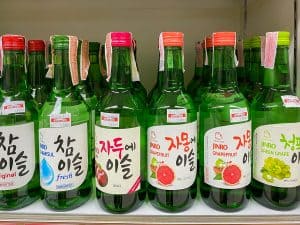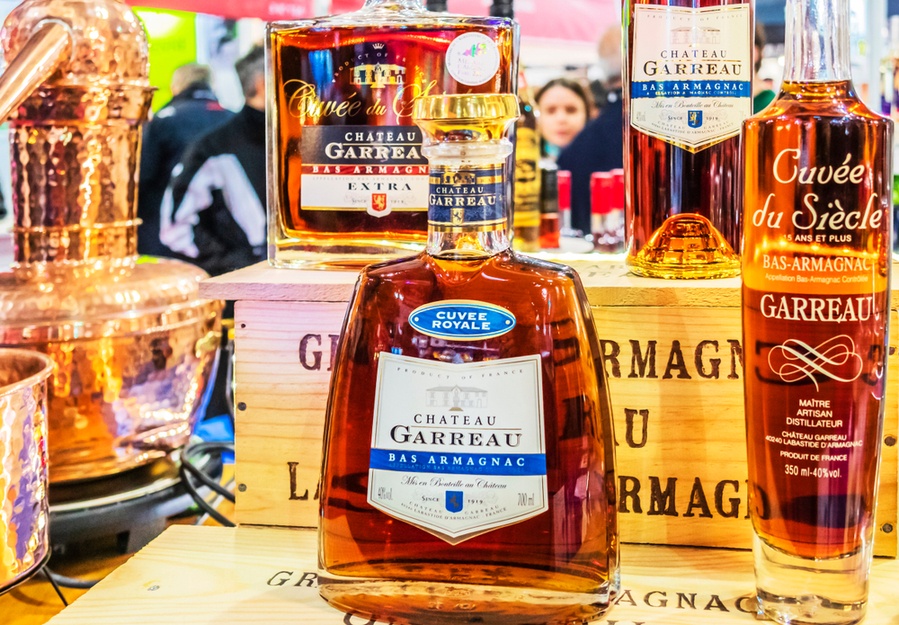
Maybe you have a bottle of Armagnac, which you bought as a souvenir (nothing wrong with duty-free shopping to spend foreign currency), honoring your French roots or celebrating Bastille Day, or you bought it out of curiosity.
You can think of Armagnac as the original craft spirit because smaller craft distilleries usually make it, and there are no big houses like Rémy Martin or Hennesy. This certainly adds a rustic charm to Armagnac.
You might have more questions than answers on how to drink and enjoy Armagnac, so let’s dig in.
Armagnac is primarily enjoyed neat. It is a slow-sipping drink that you shouldn’t rush—drinking it neat allows you to experience all the flavors and aromas throughout the drink. You can also warm the glass with your hand and discover how the flavor profile and aromas bloom into an extra dimension.
If you find it too strong, a drop or two of water can help tame the alcohol and open the drink. Apart from the D’Artagnan cocktail, which was developed specifically for Armagnac, you can substitute whiskey and cognac in many cocktails.
But why stop at drinking Armagnac? It makes an excellent sauce over ice cream or as an addition to pastries.
First, we’ll investigate what Armagnac is and compare it to its cousin, Cognac. We’ll kick your Armagnac 101 Guide off with general tips to help you understand the spirit’s complexities, offer advice on glassware, and some tips on food pairings. Then the fun begins! We’ll investigate how to drink Armagnac, from basic neat to setting it alight and everything in between.
Okay, But What Is Armagnac?
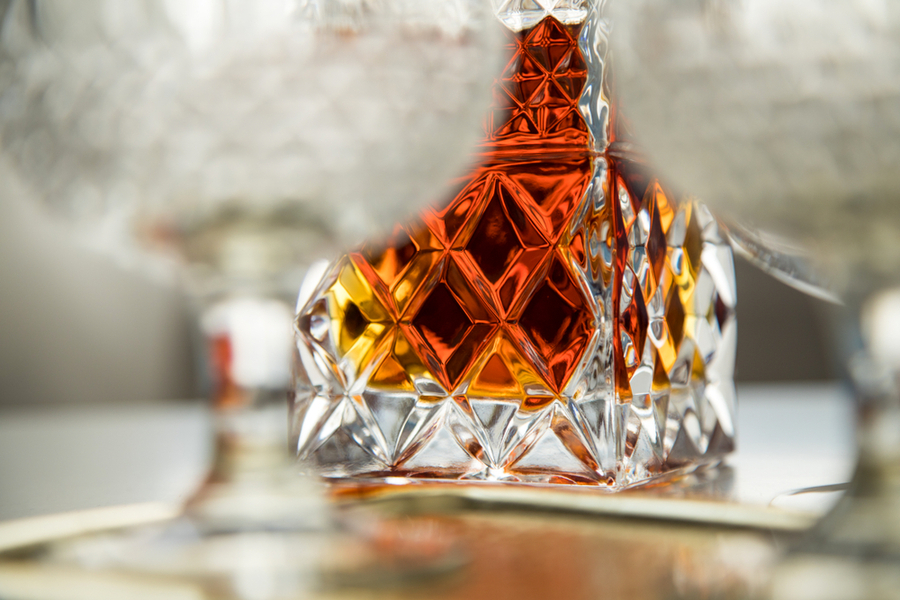
So glad you asked! We often overlook Armagnac for its more famous cousin, Cognac, which is a shame.
Like Cognac, it is distilled from white grapes—mostly Folle Blanche, Ugni Blanc, Baco Blanc, and the Colombard varieties. Producers are experimenting with the ancient Plante de Grasse, grapes that are making a comeback as well.
The key difference between Armagnac and Cognac is that Armagnac is only distilled once. Armagnac spends more time aging in the oak barrels delivering a rich mouthfeel—the producers’ patience is rewarded with a product that has more roundedness, finesse, and an almost-creamy mouthfeel.
Typically, local Monlezun black oak is used to produce the 400-liter barrels. We’ll explore the differences between Armagnac and Cousin Cognac in the table below.
| Armagnac | Cognac | |
|---|---|---|
| Grape Varieties | Folle Blanche, Ugni Blanc, Baco Blanc, and Colombard are the most common out of the 10 allowed varieties. Can also be made from a single grape variety (unheard of with Cognac) | Primarily Folle Blanche, Ugni Blanc, and Colombard. Sémillon and Folignan may also be used |
| Distillation | Once, in a stainless-steel column still (alembic armagnaçaise) | Twice, in copper pot stills |
| Barrel | Mostly Alsace and local Monlezun oak are used, but other types of oak are also allowed | Restricted to Tronçais and Limousin oak barrels |
| Age Expressions | V.S. or **: youngest brandy is 2 years old V.S.O.P.: youngest brandy is at least 4 years old X.O. (Napoleon Armagnac): youngest blend is 6 years old Hors d’âge (‘beyond age’): aged at least 10 years | V.S. or ***: youngest age is two years, the minimum age for cognac V.S.O.P. (also Reserve): youngest age is 4 years X.O.: Highest grade of Cognac, youngest blend is at least 10 years old Hors d’âge: Officially part of the X.O. designations, this usually means the youngest brandy is at least 30 years old |
| Flavor | Bright and pronounced. Rich mouthfeel. Notes of dried fruit, caramel, chocolate V.S. presents itself with crisp, fresh fruit flavors combined with light notes of caramel and vanilla V.S.O.P. offers a subtle nuttiness while the vanilla and caramel become more pronounced along with the taste of dried and fresh fruits X.O. is very much the same as the V.S.O.P. flavor profile, but now tastes of chocolate and toffee also emerge along with a nuttiness Hors d’âge offers a coffee taste in addition to dried fruit, vanilla, caramel, nuts, and chocolate | Subtler flavor. Notes of dried fruit, toffee, and syrup – see below for more. V.S. has crisp, fresh fruit flavors combined with vine flowers, light caramel, and subtle vanilla notes V.S.O.P. shows a subtle nuttiness with moderate expression of caramel and vanilla combined with dried and fresh fruit tastes and vine flower presence X.O. is almost the same as V.S.O.P, but the vanilla, caramel, and fruit tastes are more pronounced, along with toffee and coffee flavors coming to the fore Hors d’âge: same as an X.O., yet the dried fruit taste is more intense, and notes of chocolate can also be found |
| Appearance | Viscous texture | Thin, almost pure liquid |
| Aging | One year at least. Minimum 2 years if blended into a V.S. | Minimum 2 years |
| Alcohol content | Distilled to 52–60% ABV, bottled at 40% ABV (can reach 47% ABV) | Distilled to 45–47% ABV, bottled at 40% ABV (stronger proofs exist) |
General Tips for Drinking Armagnac
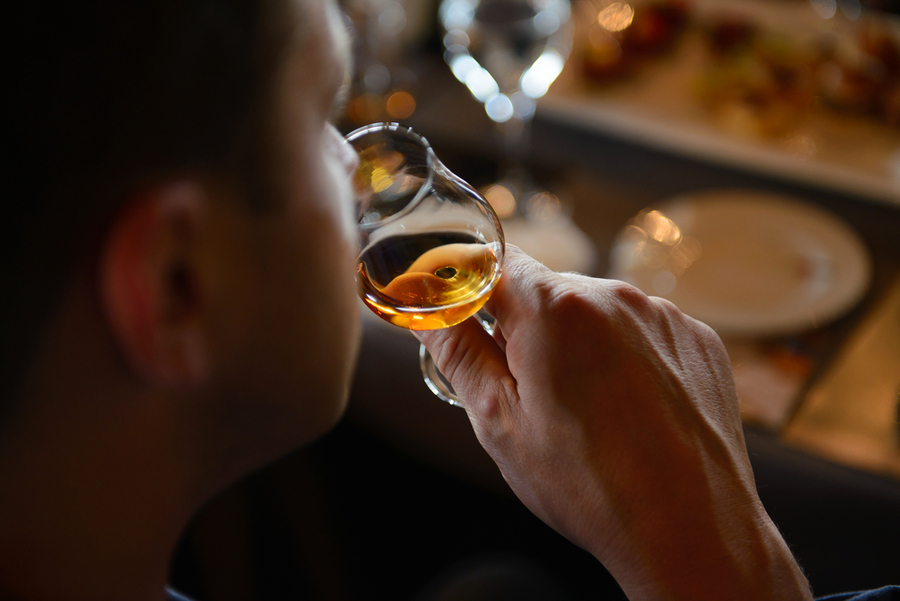
Put away the brandy snifters. Done? Good, now let’s continue.
Step #1: Serving
While it is traditional to serve French brandies in a snifter, it does not do Armagnac (or you) any favors. The best glass has a round belly with a chimney tapering upwards—this traps the volatile compounds and allows the aromas to develop.
If you are in a pinch, you can also use tulip-shaped champagne flutes. It might feel strange at first, but we think it looks glamorous, and you’ll be rewarded with a satisfying drinking experience.
Armagnac is best enjoyed neat and at room temperature (there is an exception which we’ll come to later).
Step #2: Sniffing
Joseph Nase writes in his piece, The Armagnac Primer, for New York Magazine about a trick he learned from brandy professionals.
It goes as follows: when you receive your glass of Armagnac, stick a finger in the glass and dab the liquid on the back of your hand. Just like with perfume, the alcohol will evaporate, and the aromas will remain. Let it sit for a minute.
Smell the spot up close and try to identify the aromas. You can expect to smell dried fruits (apricots, figs, and prunes) but also detect hints of flowers, butterscotch, and licorice. Quite neat!
If the above is too intense for you or not something you’d like to do while you’re with company, try the following tip Joseph offers—whatever you do, don’t stick your nose directly into the glass and deeply inhale. This is not wine.
The powerful alcohol esters will numb your smell receptors, and you won’t be able to distinguish its subtler qualities.
Hold your glass at chest level and let the aromas waft upwards—you’ll pick up on a cloud filled with toffee, caramel, pepper, vanilla, flowers such as rose, and even chocolate. Bring your glass to about chin level and softly inhale.
Soon the Armagnac will carry you away on a magical and aromatic journey.
Step #3: Tasting
Yes, we still haven’t tasted the Armagnac…
Take a tiny sip, about half a teaspoon, and swirl it around your mouth. Coat your tongue, cheeks, and even your gums with the viscous liquid. Swallow and take a breath.
Amazing, isn’t it? This way, you have engaged most of your senses.
The sight when you saw your drink, the smell when those aromas met your nose, the touch when the viscous liquid touched your lips and the inside of your entire mouth, and finally taste when you swallowed the amber liquid. You’ll probably hear fairies calling your name if you drink enough of it, but we recommend moderation.
Armagnac is not a drink you rush. You keep on sipping slowly through the evening. At some point, you might cradle the glass in your hand and warm the drink slightly. You’ll notice new aromas and flavors will emerge. It’s such a magical drink.
Step #4: Food Pairing
Younger Armagnacs (V.S. and V.S.O.P.) pair nicely with smoked salmon and caviar, charcuterie boards filled with cold meats, and lemon tart for dessert. Older expressions (X.O. and Hôrs d’age) pair well with roast duck, chocolate mousse, and Black Forest cake.
Traditional fare in Gascony includes duck cracklings (gratons), duck confit, foie gras (canned, in a terrine, and fresh), duck neck (gesier), and French duck (Magret de Canard). Vegetarian options include cepes, a mushroom like porcini, and black truffles.
How To Drink Armagnac
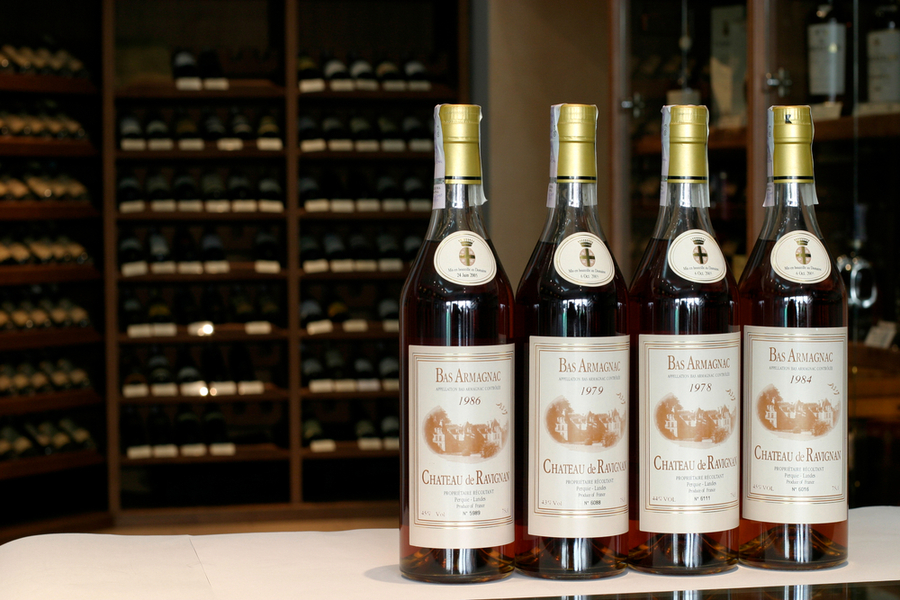
Finally, we get to the fun part, how to drink Armagnac. We’ll investigate drinking options, provide you with guidance for glassware, list some cocktails; and we’ve included a special flambé method as well!
There is no right or wrong way to enjoy Armagnac, but we’re sure the tips below will enhance your enjoyment of Armagnac.
Neat—Pre- and Post-Dinner
We can enjoy Armagnac as an apéritif or a digestif. Traditionally, it is consumed after dinner during a conversation with guests over cigars, but don’t let this stop you from drinking it as a pre-dinner drink as well! Something especially suited for pre-dinner drinks is Blanche Armagnac.
This is Armagnac before they age it in oak barrels. It is stored in an inert container, and throughout three months; they add water to bring the alcohol level, which is above 60% ABV (120 proof), down to under 45% ABV (90 proof). The resulting spirit keeps the characteristics of the grapes that were used during the distillation.
Trou Gascon
You cannot get a more French culinary tradition than the Trou Gascon! The same idea as Trou Normand, where guests are served a small glass of Calvados between the courses of a banquet-style meal. Thanksgiving is the perfect time of year to try out Trou Gascon.
The Trou Gascon is Armagnac served either with another liqueur or prune ice cream to cleanse the palate and stimulate the appetite for the next course. Some delicious ideas and recipes can be found here.
Brûlot d’Armagnac Flambé
Just like setting a Christmas pudding alight to wow your guests, the French in the Gascon region takes the wow factor even further!
Each year, following the harvest season, the stills will be fired up to produce new vintages of Armagnac. But this does not only stay in the distillery; the spectacle of lighting the Flame of Armagnac is also carried into the kitchen or dining room, where guests enjoy their dinner.
Blanche Armagnac, the new distillate, is flambéd with sugar and ends off the meal—both to celebrate the new vintage but also, perhaps, bring some pleasure to the producers who work hard throughout the year to secure a new vintage.
Why not try a Café Brûlot after dinner as they do at Arnaud’s in New Orleans, Louisiana? Instead of the spirits (Curaçao, Grand Marnier, or Cointreau) as this recipe instructable calls for, use Armagnac.
The Armagnac is set alight with a long match in a ladle, and as it burns, it is slowly poured over the clove-studded strip of orange peel. When you’re satisfied with your pyrotechnic show, douse the flames in the fire- and heat-proof receptacle (traditionally, a copper vessel is used) with hot, black coffee.
Use the ladle to pour the coffee into demitasse cups and serve.
Eating Armagnac
Why drink your Armagnac when you can eat it? We’ve mentioned Armagnac is more viscous than Cognac, so why not take advantage of this?
Plain vanilla ice cream for dessert is boring, but drizzling Armagnac over it can make it epic! You can also try some traditional fare from the southwest of France in a Tourtière Landaise—an apple pastry flavored with Armagnac.
Armagnac in Cocktails
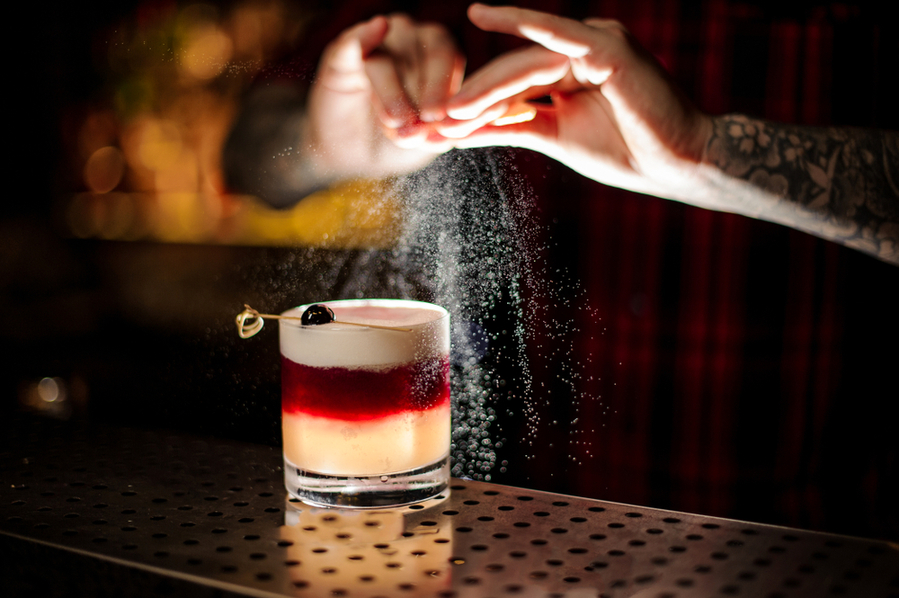
We’ve centered a lot around food now, so time to let the cocktails take the limelight.
During the late nineteenth-century phylloxera outbreak in France, thousands of acres of vineyards were destroyed. Although the Gascon region wasn’t spared, the phylloxera outbreak couldn’t thrive in the sandy soil of the region.
Producers could still produce and export Armagnac, albeit at a reduced capacity, to the US.
We’ll highlight five Armagnac cocktails that have been around before Prohibition was introduced, given Armagnac’s prevalence as the most-exported brandy during the late nineteenth century.
1. D’Artagnan
Aptly named after the fourth Musketeer who came from Gascony, the birthplace of Armagnac. To bear the name and be considered a true D’Artagnan, it must be made with Armagnac.
Recipe
Combine 15 ml (½ oz) of each Armagnac and Grand Marnier with 2 ounces (60 ml) of orange juice, and ¼ ounce (7 ml) of simple syrup in a shaker with ice. Shake it for about 30 seconds and strain it into a chilled coupe glass.
Top up with a Brut Champagne of your choice. Avoid Prosecco or sweet Champagnes.
2. Continental Sour
A European twist on the classic Whiskey Sour, which in turn became the New York Sour when red wine was added to the mixture. It finally becomes the Continental Sour because Armagnac replaces whiskey. The result is a fruiter and smoother cocktail.
If the idea of raw egg white does not appeal to you, or you have dietary or health concerns, this video offers a rundown of replacements.
‘Dry shake’ the ingredients to ensure they combine thoroughly—you’ll place all the ingredients except the red wine in a shaker and shake it without ice. Then you can proceed as normal.
Recipe
Combine ¾ ounce egg white (or your replacement), 1 ¼ oz (40 ml) Armagnac, ¾ oz (20 ml) sugar syrup, and ½ oz (20 ml) lemon juice in a shaker and dry shake the ingredients. Add ice and shake the ingredients again to chill them.
Strain into an ice-filled glass. Gently pour ¼ oz (10 ml) red wine to allow it to separate towards the top.
3. Armagnac Stinger
According to legend, this was playboy Reginal Vanderbilt’s daily tipple of choice. The Stinger was also adored by New York high society before Prohibition. Cognac is replaced by Armagnac to punch through the orange bitters and crème de menthe.
This is also one of the simplest recipes we’ve come across in a long time—keeping things simple at the bar has its perks!
Recipe
Combine 2 ounces of Armagnac with 1½ ounces of crème de menthe in an old fashioned glass with ice, stir until everything is combined, add a dash of orange bitters, and garnish with a sprig of mint.
Simple, yet sophisticated.
4. Twist My Armagnac
If you’re still not convinced to try Armagnac in a cocktail, this might be the cocktail to put those fears to rest. The vodka and pineapple help the Armagnac’s subtleties to emerge, and this should twist your arm(agnac) to try it in other cocktails too.
Recipe
You need ¾ ounce (20 ml) of each vodka, Armagnac, and pineapple juice and ¼ oz (7 ml) of rich demerara syrup.
All the ingredients go into a shaker with ice and are shaken until all the ingredients are combined and well-chilled.
You’ll double-strain this over an ice ball or large ice cube in a rock glass. A pineapple slice rounds this cocktail off with a dramatic flair.
5. Jamboree
Last, but certainly not least, a recipe that features white Armagnac. At first, you might think we’ve gone a bit mad when you see the ingredients, but don’t worry, trust the process.
Gregory Buda, bartender, and director of education at NYC’s The Dead Rabbit, created this recipe to showcase white Armagnac. The recipe calls for specific liquors, so do your best to stick to the recipe; otherwise, the outcome might not be as desired.
Recipe
In a mixing glass, you’ll combine the following:
- Domaine d’Esperance Blanche Armagnac (1¼ oz, 37 ml)
- Cocchi Americano aperitif (¾ oz, 20 ml)
- ¼ ounce (7 ml) Blume Marillen apricot eau-de-vie
- ¼ ounce (7 ml) Yaguara plata cachaça
- ½ ounce (15 ml) Fusion verjus blanc
- 1 teaspoon black cardamom syrup
Mix it all together with ice until it is well-chilled, and strain it into a Nick and Nora glass. Garnish your final product with a lemon twist.
You can find more interesting recipes by following this link.
Conclusion
For too long, Armagnac has been hiding in the shadows while Cognac has taken center stage. We hope you’ll go out and try or even buy a bottle of Armagnac and discover this amazing spirit for yourself.
Unlike whiskey and Cognac, Armagnac does not spoil once it’s open and can be stored for a long time. Of course, over time, it might evaporate—the main takeaway is to keep the bottle upright and never store it horizontally.


